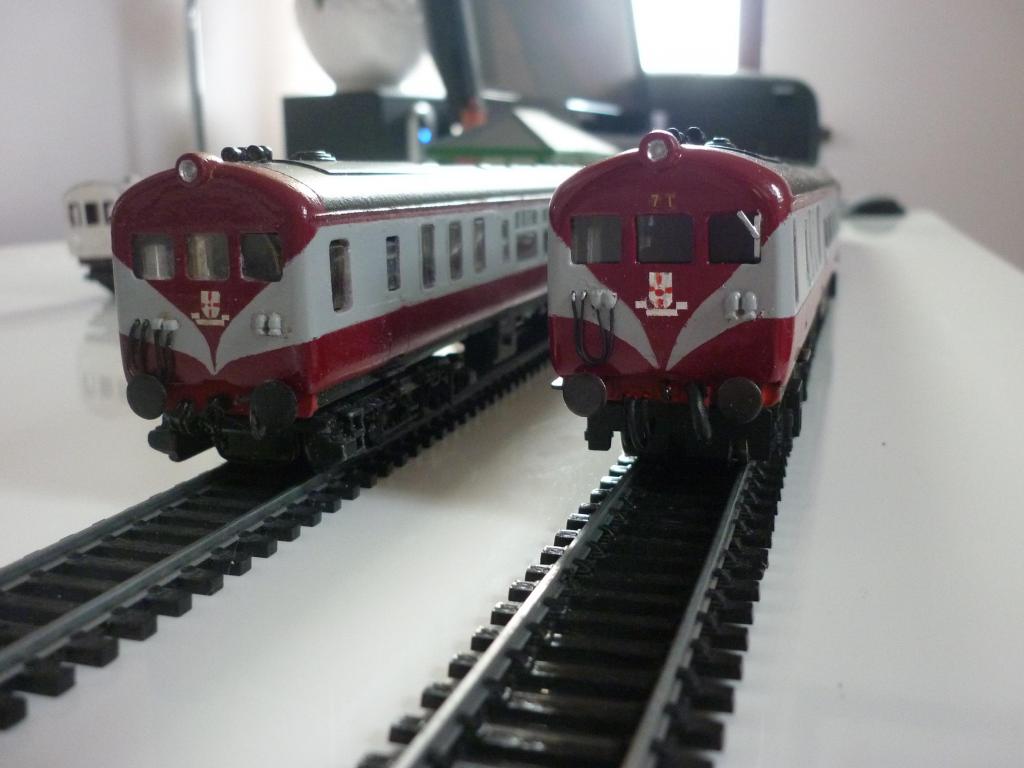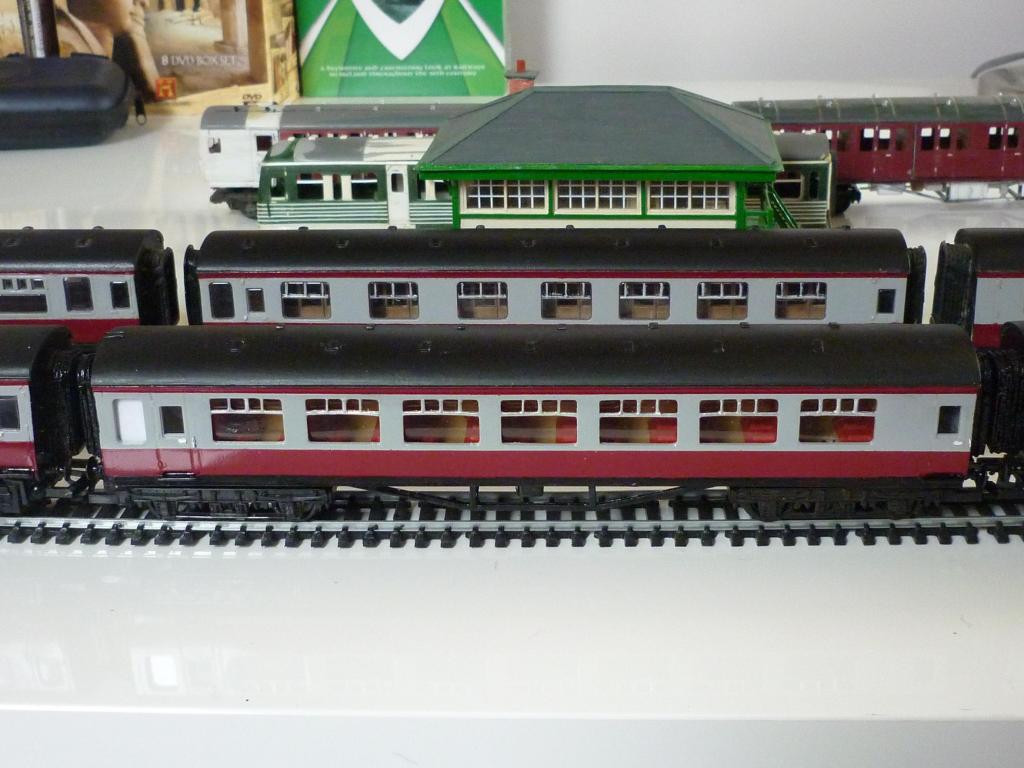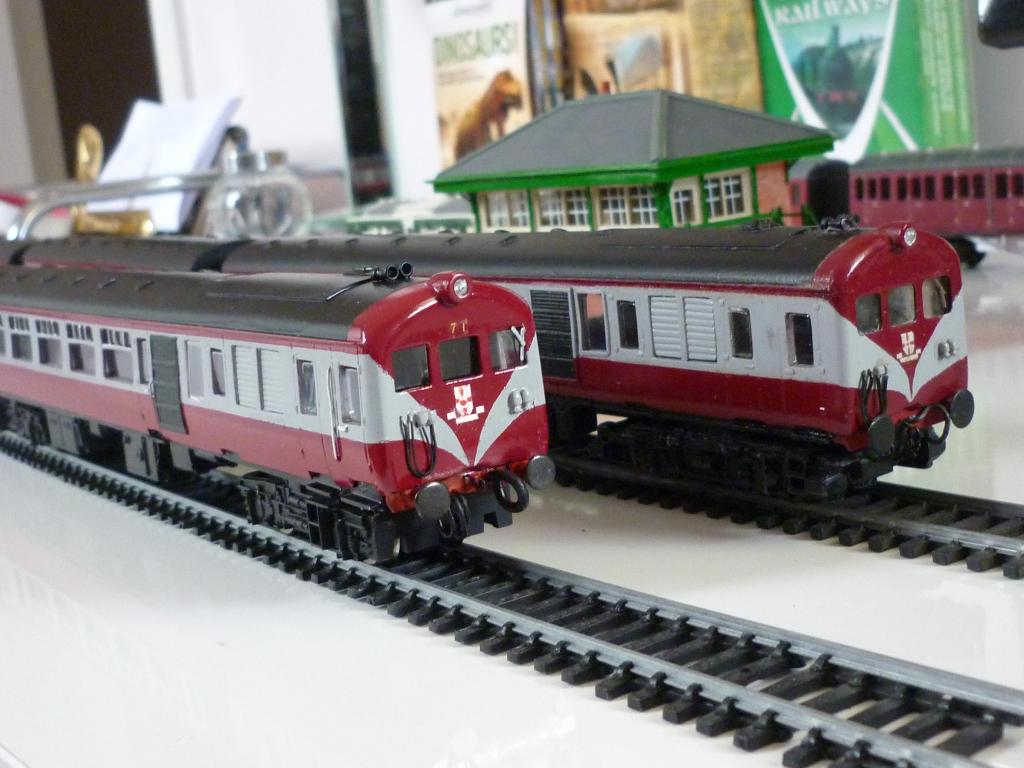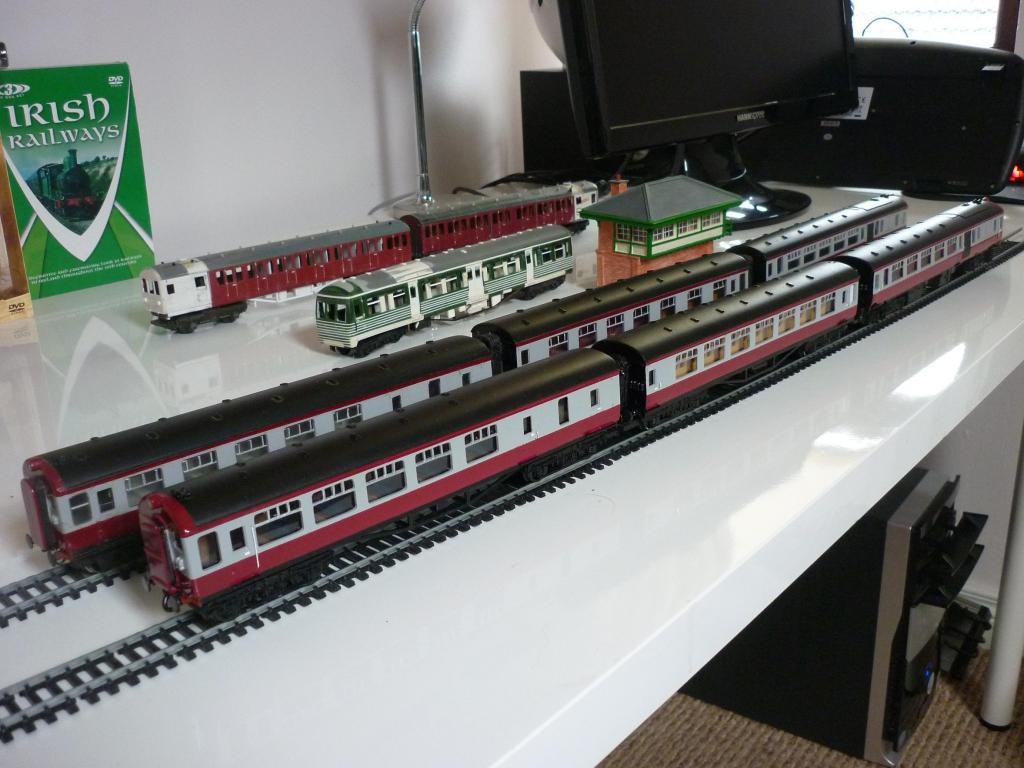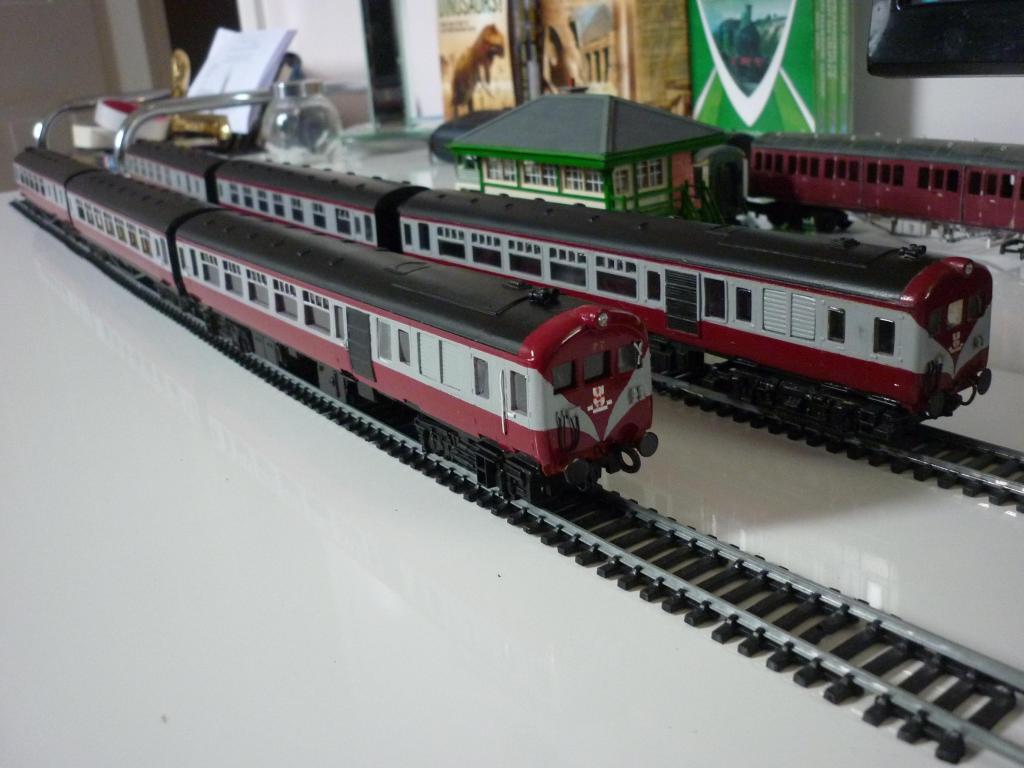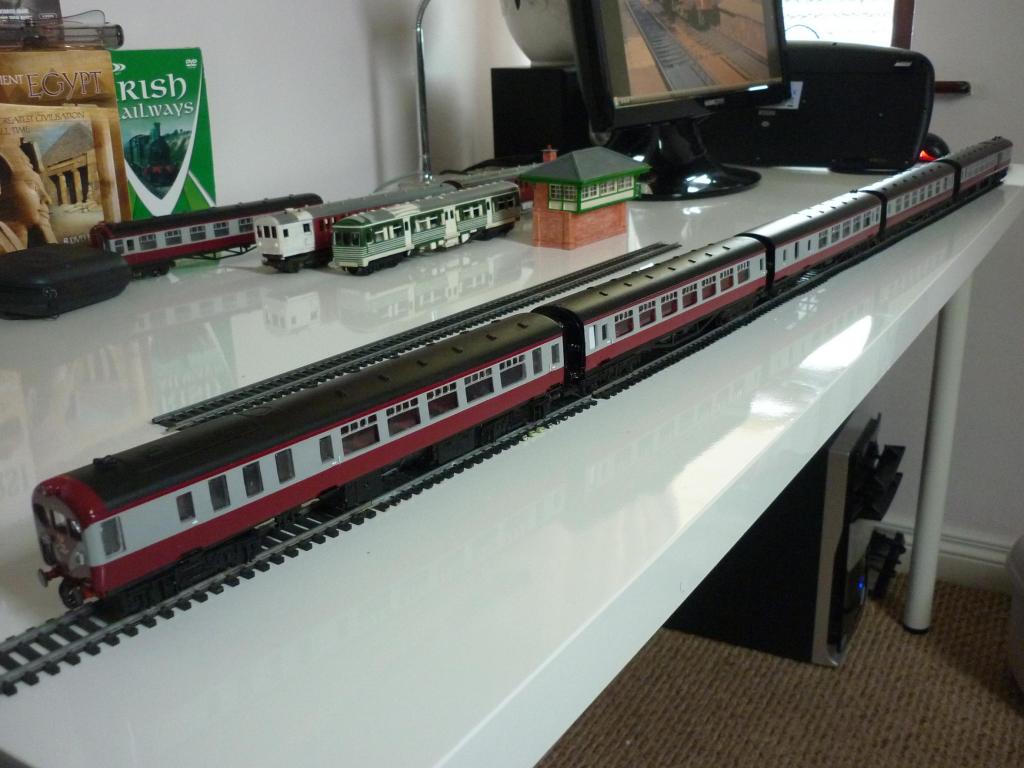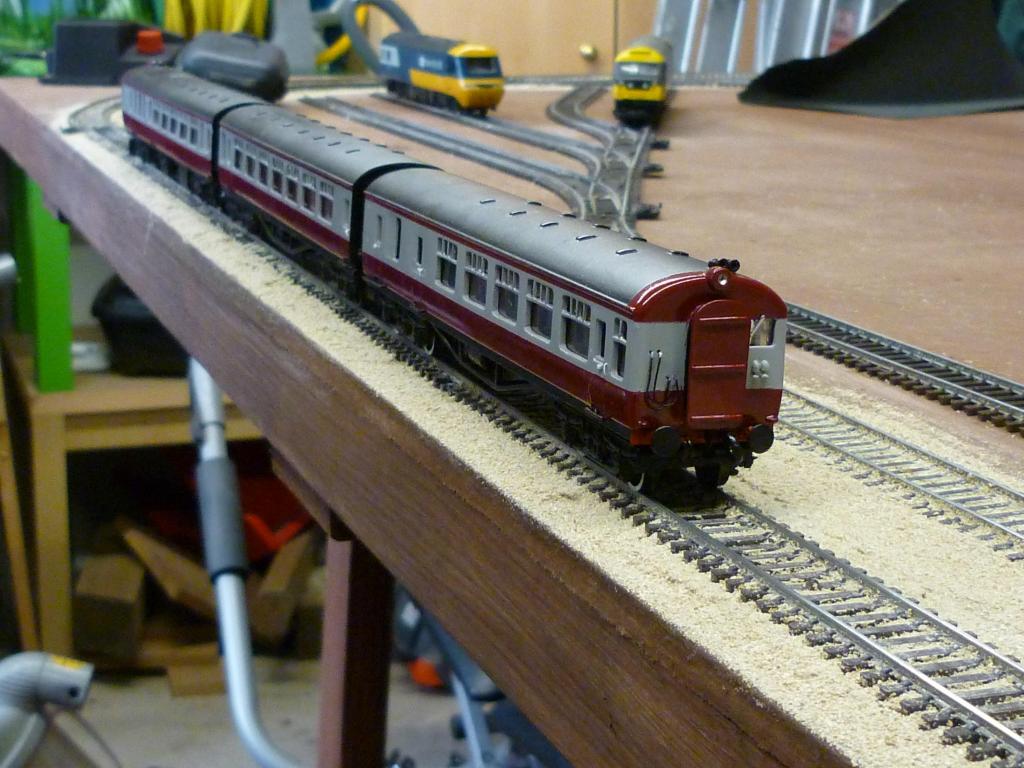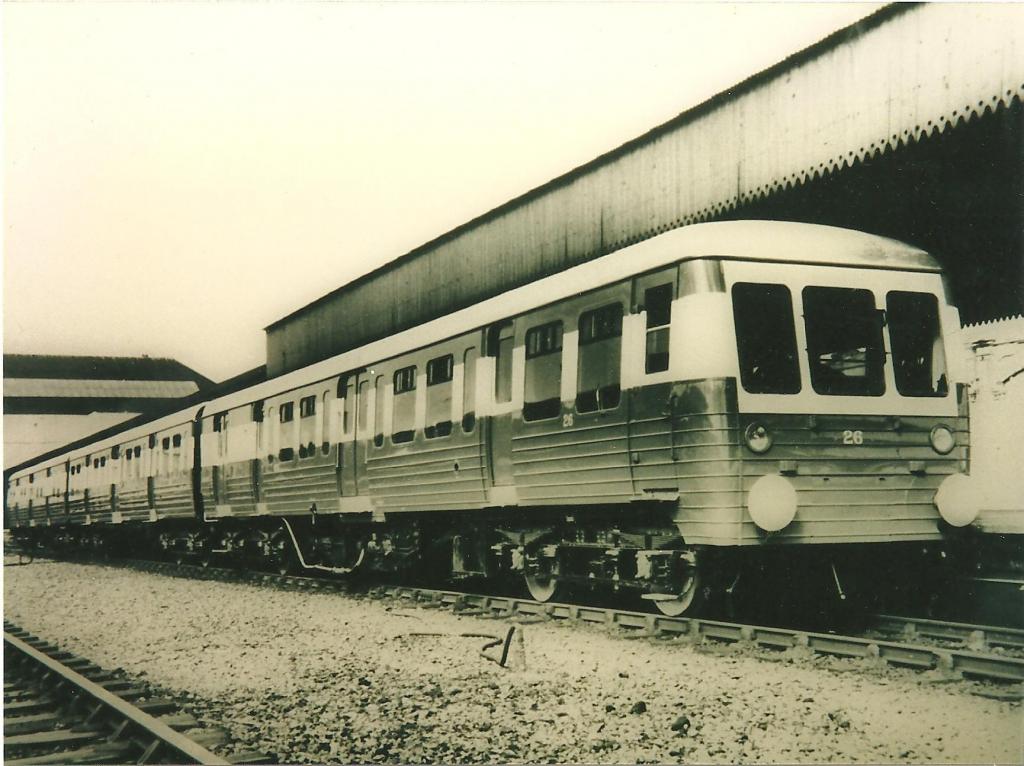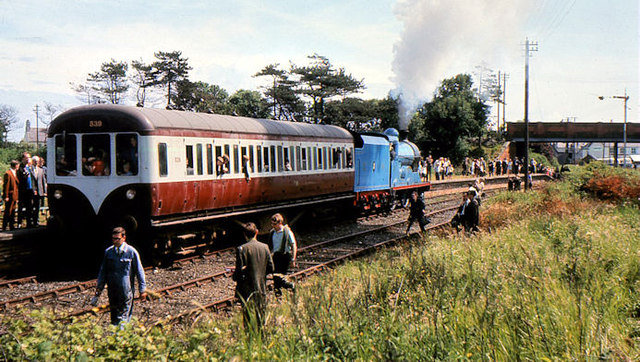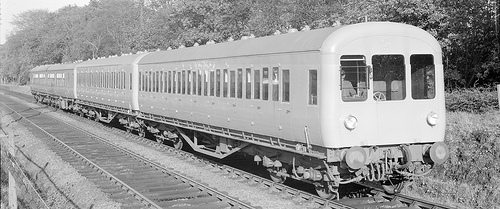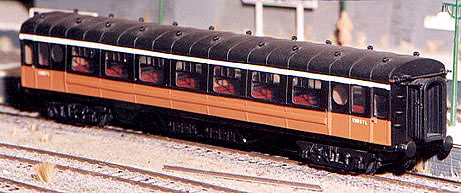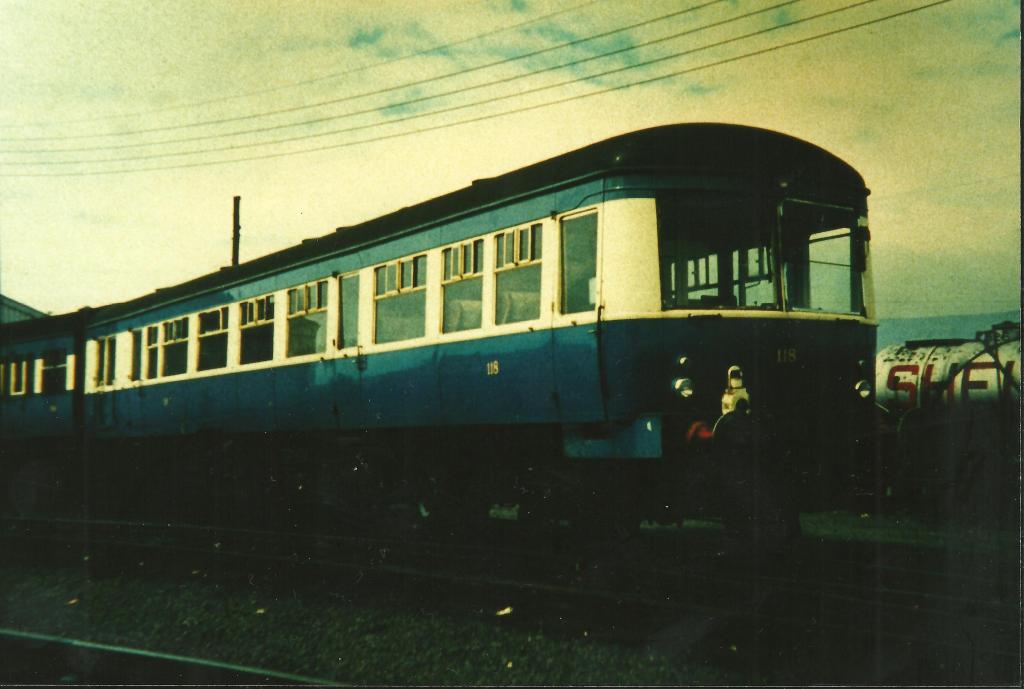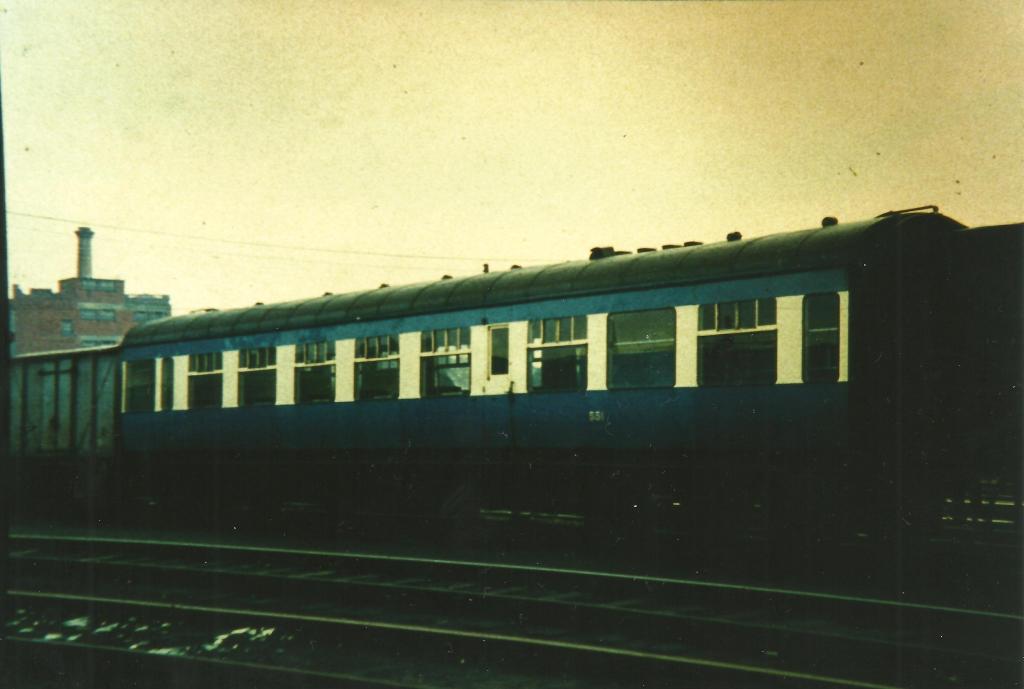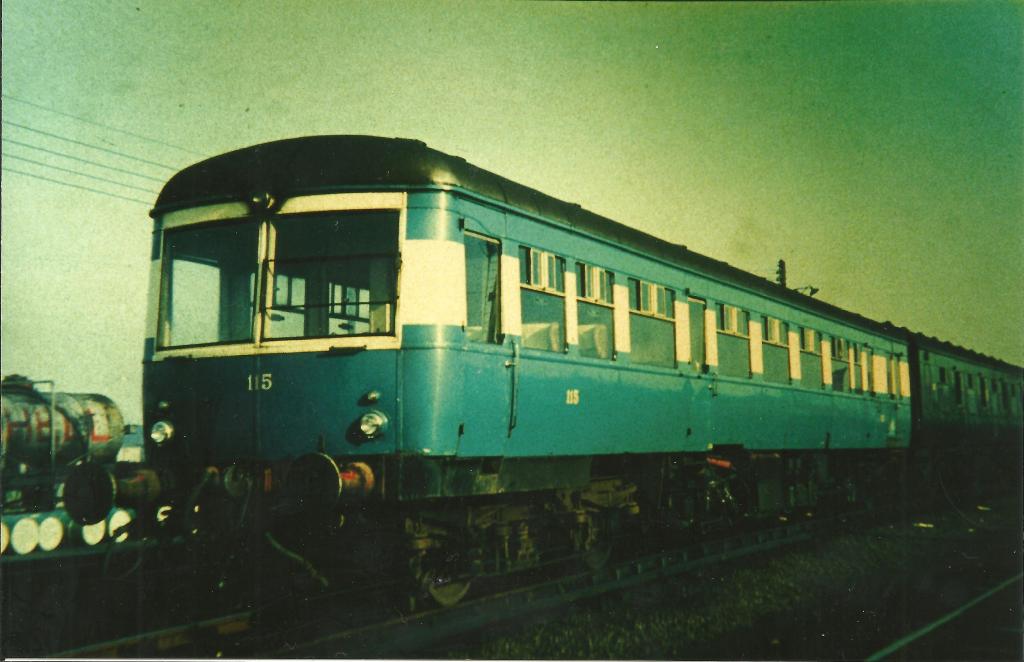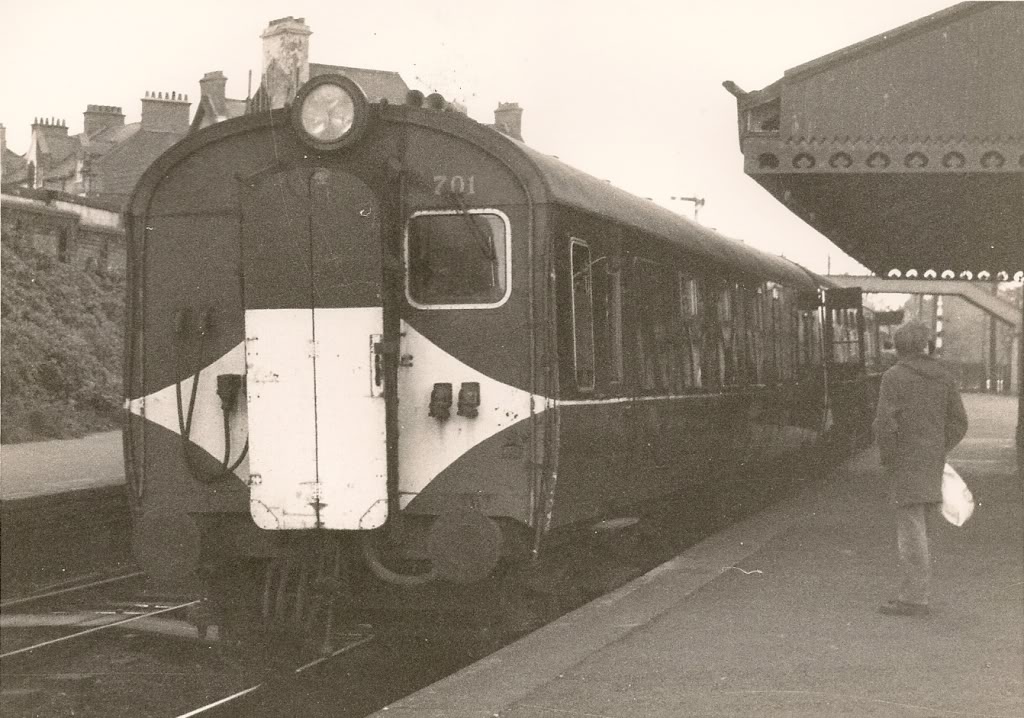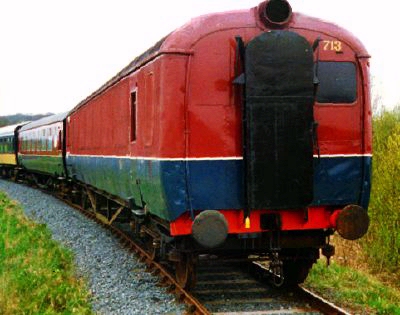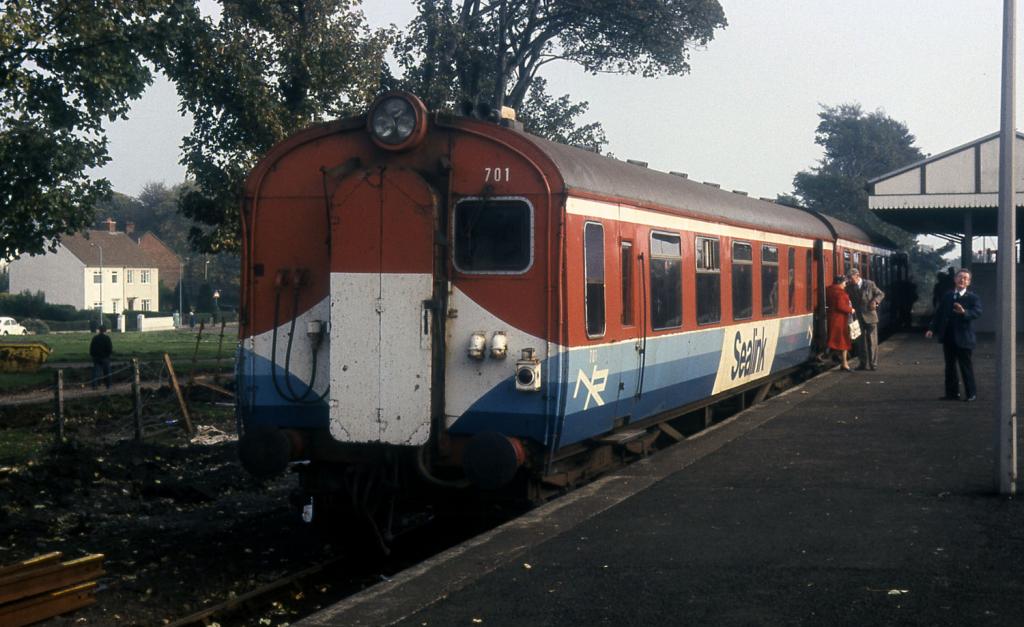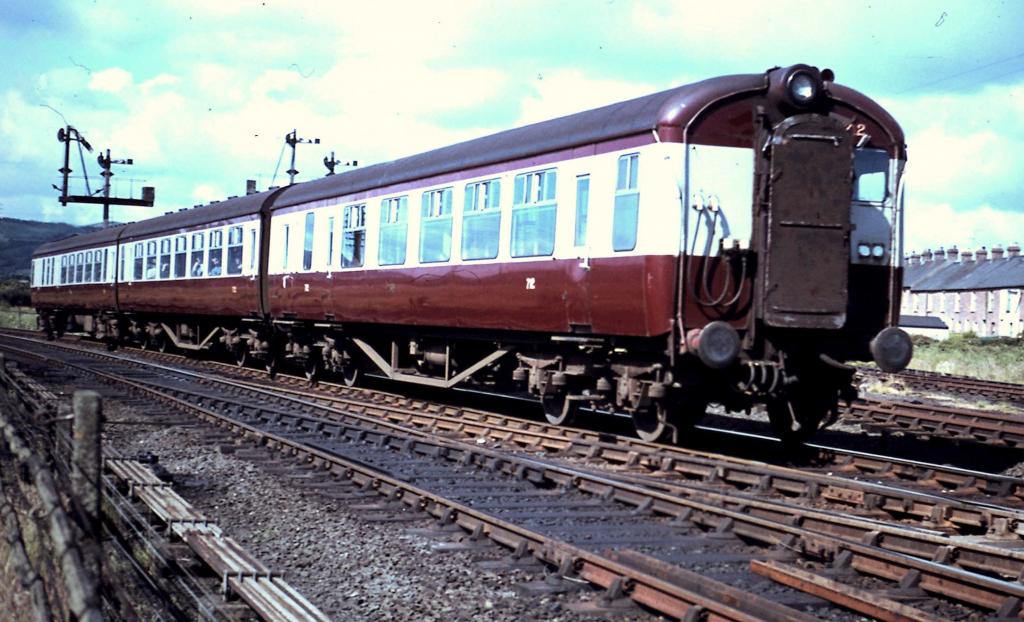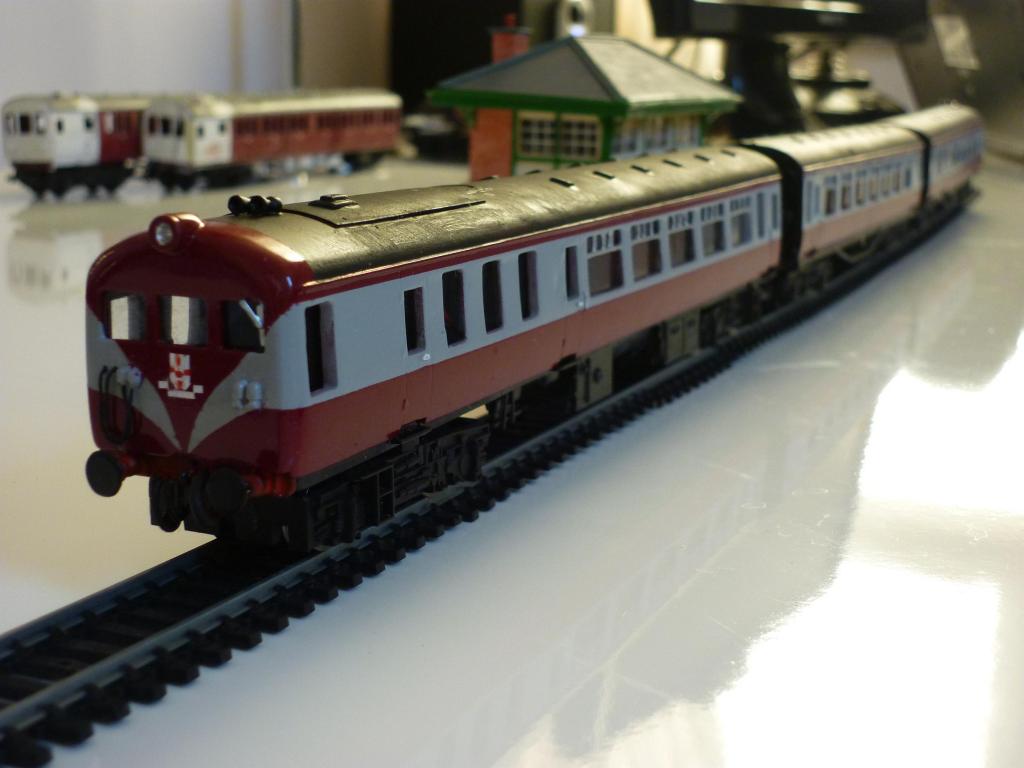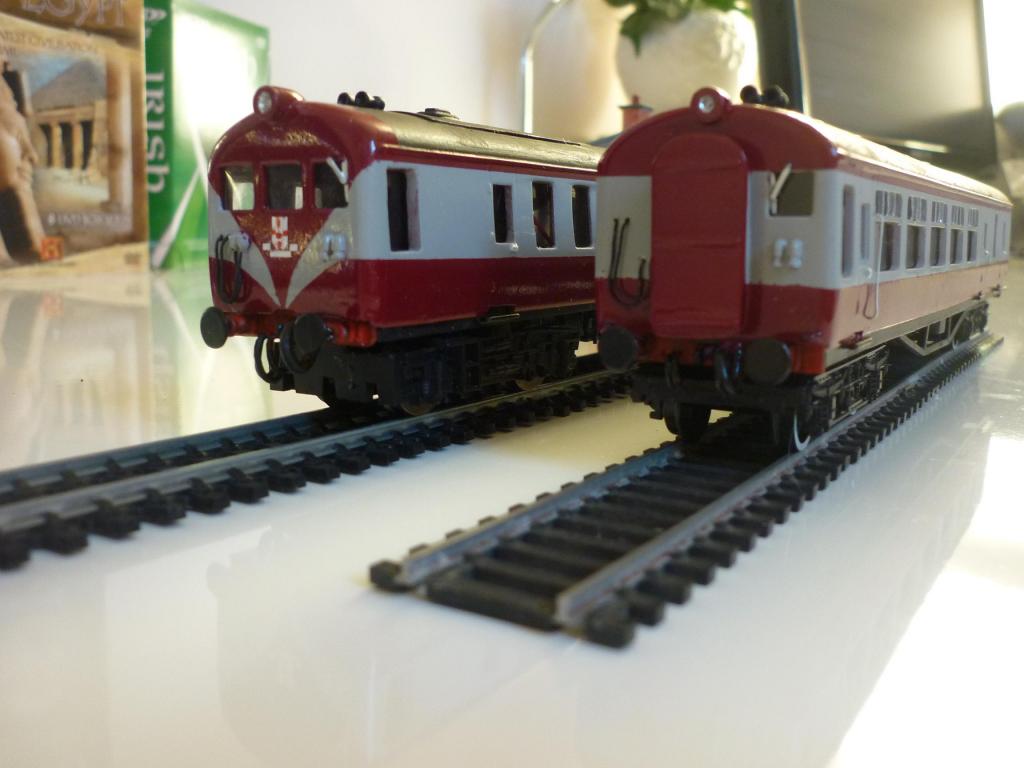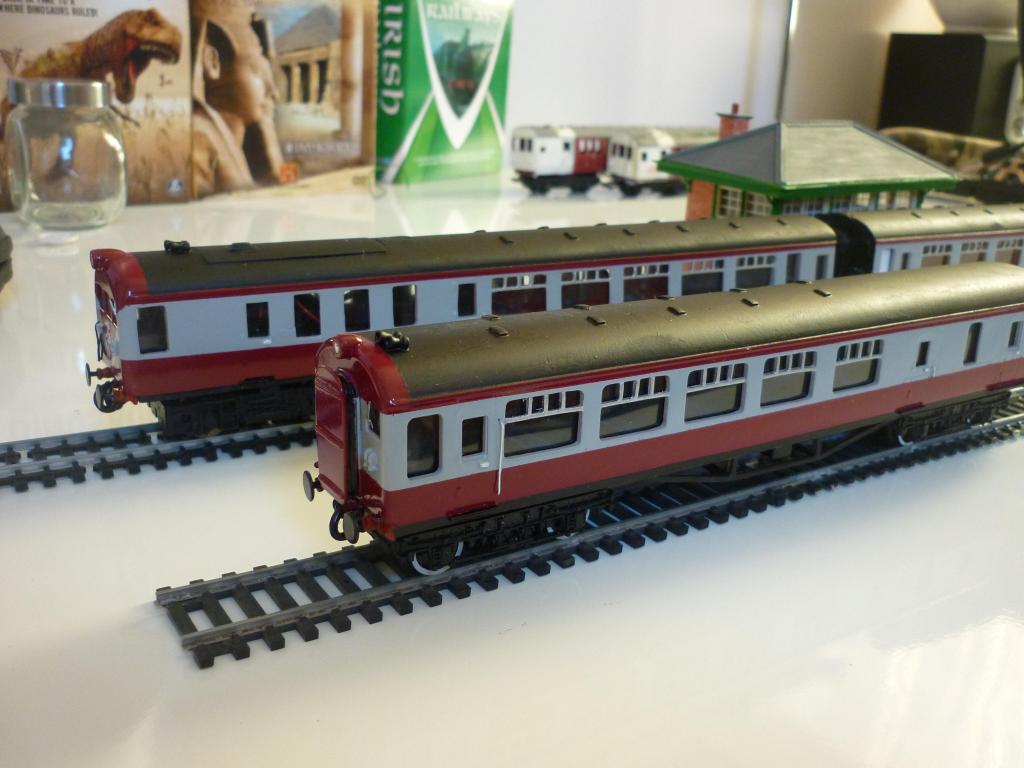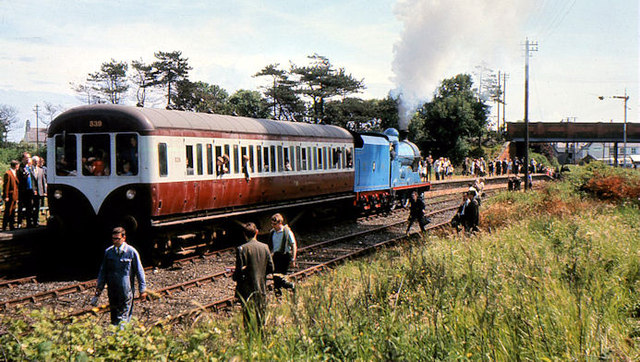-
Posts
183 -
Joined
-
Last visited
Content Type
Profiles
Forums
Events
Gallery
Blogs
Store
Community Map
Everything posted by 33lima
-
Wow! A work of art, Nelson, which would grace any collection or any museum.
-
OK final set of pics before the set takes to the rails...sorry, the post, for Galway. Only work done since the previous pics is numbering cab fronts, flush-glazing the non-passenger windows in the power car and painting all buffers a dark metallic colour. As with the 80 Class's farewell photos, the set is posed with my previous effort (far side) which dates from about 1995 and was powered with a Tri-ang Hornby Hymek power bogie, as that was about all that I could readily get my hands on at a modest price, back then. The new model, having a Hornby Ringfield job with a 5-pole motor and trailing bogie pick-up, should perform rather better. The pics illustrate the difference between the Hornby LMS-style windows, un-modified, on the original set's trailers, and the correct, wider, BR Mk-2 width (?) windows on the new trailers, the lack of flush glazing the price paid for greater accuracy. Last pic is a 5-car set, with the new set leading and two cars from the original set at the rear. All pics I won't be able to take again!
- 60 replies
-
- uta
- uta railcar
-
(and 2 more)
Tagged with:
-
Great pics of a gorgeous layout. A little slice of Irish railways and countryside brought to life, and a fine model of 001 at the head of a good rake of authentic wagons rumbling through it; it's all there. Top notch stuff. This should be in a railway mag, if it hasn't already been.
-
Works of art - lovely models, all!
-
Wow! that's quite a model!!!
-
Hi Nelson noted author and modeller Steve Johnson (whom I helped with some minor research for his Irish Railway Atlas & Gazeteer, after we corresponded while I was the editor for the early issues of 'Irish Lines') about 1997 produced these as part of a series of livery profiles, I think using scanned works drawings (he probably got the UTA ones from me, via the UFTM!). They may have been intended for publication. He used to send me a set of the latest versions for review. The final set I saw had about 6 pages of MED profiles and other pages of profiles covering the types I mentioned above (no steam locos). I don't know how it ended up - haven't been in touch with Steve for ages - but unfortunately if it was for a book it didn't get published. Fortunately I still have the ones he sent me, including the one above. Ivor Sorry to hi-jack your thread, Andy, keep the GN pics coming!
-
Since the 'turquoise train' I remember was definitely a railcar, then either my recollections are mixed up and it WAS MED14 in the cream-over-pale-green livery pictured in 'Diesel Dawn' or it was after all an MPD set being tried out on the Bangor line, contrary to reports in the excellent '35 Years of NIR' that MPDs only got to Bangor twice, in April 1977 on a football special and again in October 1979 on an RPSI MPD farewell tour. Given the UTA was known for experimenting with different railcars on different sections, I suppose it's fairly credible that MPDs were tried out on the Bangor line before the Middlepath Street bridge was dropped in 1965. The arrival of non-corridor and 'bus-type seated' MPDs in the late 1950s suitable for short high-density runs, turned out in 'Catherwood Blue', would tend to fit in with my Carnalea sightings, from the early 1960s sometime. Incidentally I had a look at Stephen Johnson's colour profiles from the mid-1990s and he portrayed MED 14 in 'Catherwood Blue' with wasp stripes on the front. His caption says this was only applied to # 14, the same vehicle pictured in pale green with cream uppers, no wasp stripes and the overpainted Red Hand disc on front, in 'Diesel Dawn'. I don't know what Stephen's source was re MED 14 but this series of profiles was a work-in-progress 20 years ago so was subject to possible later correction. I trust if watching that he won't mind me reproducing this one sheet below. Steve may have got further but by 1997 the coverage was MEDs, 70 Class, 80 Class, NIR diesels, some CIE/IR diesels, NIR Mk2s and CIE/IR Mk2s - if he ever did profiles for the GNR railcars I don't think I ever saw them, or found out where the project ended up, but it was an interesting and unique effort.
-
FWIW, my original 1992 blue & grey 80 Class (in the middle below) used Ford Polar Grey as a base colour, which was a little dark; whereas my recent one used Ford Dove Grey (which to my eye is a ringer for the base colour used with maroon on the 450 Class, but maybe a bit 'warm' for the 80 Class, tho I think better than the Polar Grey). The blue on the recent model as Humbrol 14 Gloss French Blue which is what I remembered using for the 1992 model, tho it looks different, maybe it was Humbrol 25 Matt Blue, varnished, on the 1992 model.
-
Hi Ral I just use car aerosol grey primer from cans, Halfords in this case, acryllic.Seems to give a decent finish, without any 'orange skin' effect.
- 170 replies
-
- nir railcar
- nir 80 class
-
(and 2 more)
Tagged with:
-
Right nearly done now! Test run went ok after cleaning wheels and track. Just needed to cut back one of the corridor connection arms which I hadn't noticed was sitting way out and caught the next coach on turns. I've found the gold waterslide transfers (Mabex bus numbers) in a box in the loft and if they are still usable after about 20 years I'll number the fronts of the power car and driving trailer. I had already repainted the roofs before these last pics were taken, using a matt black spray as brushing produced a rather poor effect. I suppose the roofs should be mid-grey to go with the general ex-works finish but to me, a sooty and/or greasy black just looks right, with UTA or NIR railcars, and is how I remember them anyway. Conversely, I don't know if they ever painted the driving trailer's corridor connection cover maroon, but to me it looks better like this than sooty black or brown. This was, after all, the UTA's last railcar and it deserved a nice finish even if the roofs got dirty Just need to fit the transfers (if they work!) and trim and re-fit the over-long corridor connection bracket then we're done. Not exactly my favourite UTA/NIR railcar. And to be honest, as a kid I didn't even identify them as a distinct type from the MPDs, for all I saw of them in the late 1960s and early 1970s. But they have a certain presence and their engines, passed on to the 450 Class, have (assuming they weren't replaced) only just retired, over forty years after the 70 Class was introduced. At least they survive in model form, Colm Flanagan's original version being justly well-known ( http://newirishlines.org/2009/09/27/the-utas-finest-train/ ) and others can be seen made from Worsley Works etches, like a new set from Colm and another from David Orr: http://www.worsleyworks.co.uk/Image-Pages/Image_4mm_Class70.htm Here's to another class gone, but not forgotten!
- 60 replies
-
- uta
- uta railcar
-
(and 2 more)
Tagged with:
-
Some other observations on railcar liveries: - I don't think I have seen an MED or an MPD with plain green ends - they either had 'ivory' upper cab fronts; or that plus wasp-stripes; or just the wasp stripes. The only plain ends were those MPDs turned out c.1959 in 'Catherwood Blue' and by about 1961 these had wasp-stripes added; - likewise I think the UTA's AEC and BUT railcars went straight from GN blue & cream to UTA green with wasp-stripes, tho I think one of the articulated sets acquired wasp-stripes on top of the blue and cream, first; - credible captions indicate wasp stripes were in widespread use by 1961 - for a time on some cars, underneath the 'ivory' cab front uppers, in others and as standard, on a plain dark green (or 'Catherwood Blue') cab. I would be fairly sure these were introduced after the court case which followed the accommodation crossing crash in 1959 in which brand-new MPD 58 was lost. The motorist was held mostly responsible but some blame was placed by the court on the UTA because hedges hadn't been trimmed as they might have, so visibility was an issue (reported in an IRRS journal). It is surely no co-incidence that wasp-stripes appeared soon after this court case. Incidentally, photos in a Co Down railway society booklet I can no longer find had an article on this crash (or was it on the role of the steam crane) and some pics showed that 58 was in 'Catherwood Blue'. She was on her side, not quite on her roof, and as the late WAG MacAfee (later NIR CME) confirmed she was recoverable but was burnt out after sparks from an acetylene torch - being used to cut engine mounts to enable lightening and recovery - fell through a floor hatch and set fire to upholstery. A bucket or saucepan brigade from the nearest house was all the water available but didn't succeed in preventing the brand-new MPD from being burnt out. - the 'white' (which I'm calling here 'ivory') that was used on upper cab fronts in the early 1960s (and before that, for upper cab fronts and other trim) was officially called 'Pale Green' and was a 'shade of white' with a very pale green tint. I suppose it's possible this was replaced some time by the late 1950s with a different, more white shade but Pale Green is what the colour was officially called (in the UTA's April 1952 booklet 'Multi-Engined Diesel Train Development') that was applied to the first MED set and it looks no less white, or off-white, than any shade applied to later MEDs or MPDs. So I think that description stands, unless there is written proof that a different shade was used. The same booklet (a copy was available at the UFTM and the Linenhall Library, last time I checked; mine is a photocopy, courtesy of Mark Kennedy at the former) describes 'UTA green' as 'Deep Brunswick Green'. Notwithstanding variations in colour photographs, I'm not clear what the evidence is that the shade of dark green changed, over time; the slightly bluer cast on some (but not all) earlier photos can I think be explained by variations in light, film, processing, variations in different batches of what's nominally the same paint etc. I THINK I've only every seen one pic of a vehicle - an MED slam-door trailer, in 'Diesel Dawn' - painted in maroon with the narrow grey side panel. Even the few slam-door 'suburban' MPDs that were repainted into maroon & grey before conversion to open seating - obvious candidates for the 'suburban narrow stripe' livery - seem to have got the broad grey stripe. - I don't recall seeing a confirmed pic of a Bangor line bright green and cream 'sector' MED without the red 'artificial buffer beam. The most likely candidate seems this shot of a set led by 26 at Queen's Quay in the 'narrow band' version, which carries its number high on the cab front, not as was usual on the red 'buffer beam', indicating that it may have lacked this feature. Certainly, the red 'buffer beam' seems to have been the norm on this short-lived livery; - were there two shades of blue in the GN sector blue and cream? There are so many photos, including some possibly taken at the same time, which suggest that the blue on some BUTs was darker, like what I'd call royal blue, while others, mainly AECs, had a more sky blue shade, more like the GN passenger loco colour. Were there two different shades of blue? I've no idea! - and last but not least, what was the 'Turquoise Train' I recall seeing from near Carnalea in the early 1960s? An MED set in 'Catherwood Blue'? An MPD set on trials? Or an apparently unphotographed and un-remembered repainted GN AEC set on an excursion? The latter must be very unlikely tho it seems the likely candidate, a 'Catherwood Blue' overall MED set is also unphotographed and un-remembered (the one with cream uppers pictured in 'Diesel Dawn', MED 14, is close but doesn't fit the bill). Noted modeller of Irish railways and author Steve Johnson in the 1990s compiled on a PC a fairly extensive set of coloured profile livery drawings of UTA, NIR and CIE diesels and multiple units, going through a few iterations as we discussed their accuracy. Possibly this was with a book in mind but they never made it into print or surfaced online. Steve's site ( http://website.lineone.net/~sjohnson40/IR1.htm ) no longer works on my PC beyond the home page and I haven't been in touch in ages but it would be great if he'd publish his profiles online somewhere. If he'd permit it, I'd scan and put on flikr the set I have.
-
Hi Kirley The first two driving trailers (711 + 712) were completed very early on, and the colour pics of the first 70 Class's unit's trial run from York Road in 1966 that are featured in 'Diesel Dawn' and 'UTA in Colour' (taken by Derek Young I believe) show this is a three-car set with a driving trailer at one end. So in that sense, 'the original set' was a 3-car one. While a 6-car set, with a power car at either end, was intended to be the normal consist for main-line work from York Road to Waterside, 3-car sets were used from the beginning too - the latter book has a pic of a 3-car set on a Larne line service in 1967. Colm Flanagan in 'Diesel Dawn' says that the original plan was for two 6-car sets and two 3-car sets with the rest in reserve but with the addition of an 8th power car and the realisation that 3-car sets were often more useful, more driving trailers were built or converted from trailers, two in 1968-69 (713 & 714) then two more in 1976-77 (701 & 703). A nice colour pic in MHC Barker's 'Irish Railways Past & Present Vol 1' [was there ever a Vol.2?] shows what appears to be a 7-car set (possibly including some ex-GNR trailer conversions) led by NIR-badged 77, leaving Dublin on the Enterprise in August 1969.
- 60 replies
-
- uta
- uta railcar
-
(and 2 more)
Tagged with:
-
Here's how Steve Johnson did it a few years back, albeit starting with the Hornby 57' Stanier compo look-alike - see Issue 6, Spring 1994, page 14: http://newirishlines.org/archive-2/
-
PS Richard kindly had me down to see his railcar slides when I was researching the MEDs and MPDs back in the early 1990s. He was quite happy for me to photograph the projected slides with my trusty Praktica BX-20, directly from the projection screen. I'm sure he won't mind my reproducing these GVS ones for a fellow enthusiast. Naturally these don't reflect the quality of the originals which are copyright, Richard Whitford. Moderators please delete if I'm doing anything unmentionable! Richard's pics are a wonderful source on those long-gone days, especially as regards the railcars at which many seemed to turn up their noses.
-
Cheers Andy. My distinct railcar memories start with the wasp-stripe era, tho I recall seeing an 'ivory' upper on a railcar with a corridor end leading as it negotiated the bridge at Bridge End just beyond Queen's Quay which must have been no later than about 1961-2. And some eau de nil stuff at Yok Road - and that elusive 'Turquiise Train'. I know many MPDs were turned out in that colour from new from about 1958-9 and wonder if one of those was tried out for a while on the Bangor line, tho they say there were only two MPD visits to Bangor and neither fit that period. But when no less than Richard Whitford doesn't remember the 'Turquiose Train' (I quizzed him in the mid 1990s) I begin to doubt my sanity...
-
From the pics I've seen, the two original trailers (711, 712, the type I have modelled) and the other two added 1968-9 (713, 714) all had these small windows. So did 701 (part of the Sealink-liveried set) and 703, the trailers converted to driving trailers in the 1970s. Don't think I've ever seen a 70 Class driving trailer with anything but a single, small window, apart from 714 (and I think also 713) which had an even smaller window on the other side of the corridor connection, in the maroon and grey era anyway. A hard target for stone throwers but not the nicest feature of the 70 Class, on power cars or trailers.
- 60 replies
-
- uta
- uta railcar
-
(and 2 more)
Tagged with:
-
Nearly done now. Power car roof needs a second coat, a lost buffer or two need found or replaced, a proper test run made and any final adjustments sorted. I couldn't find any decal film for the cab front crest so used four little cuts (one for the shield, three for the banner) from a white sheet intended for PC printing of transfers, which is self-adhesive. The red detail was applied with a thin, pointed sliver of plasticard; not very precise but like the last one, but it captures the look, at normal viewing distances. The lack of flush-glazing is a bit noticeable in the power car due to the thick sides and lots of non-standard windows but less so in the passenger window area and the cab front as the glazing strips in those areas are inset, sitting in a recess. Not a big issue with the trailers as these are relatively thin-sided Hornby Staniers; the usual flushglaze sets weren't usable as I opted to reproduce the wider (BR Mk2-width?) windows fitted to the 70 Class. Seats in the centre car and power car are red, blue in the driving trailer which is right according to the Midland Irish Broad Gauge Carriages book by Desmond Coackham. Modified RTR seating units were used in the trailers, scratchbuilt for the power car, but with a gap at the inner end because of the room needed for the wiring to the trailing bogie. Wipers are just little bits of strip plasticard glued at an angle, painted silver and stuck to the sides of the window with Clearfix, which doesn't damage paintwork. All vehicles were ballasted with fire cement, pushed into voids. I ended up leaving the Hornby HST bogie frames alone; they're not too bad for a 70 Class power car and that soft plastic is easy to mess up once you start hacking it (and not the easiest to fit replacement bogie frames to either). Handrails are thin florist's wire, painted white which I think is right. Similar stuff painted black serves as the jumper cables; I fitted these only to the outer ends, having fitted steps which left no room to the inner ends before I found a photo (in that Midland book) which showed that the inner jumper cables were fitted high on these ends, not at buffer beam level as I had assumed. I have a sheet of waterslide gold numbers somewhere and if I can find that again, I'll number the fronts of power car and driving trailer, at any rate. I'll post some better pics before despatch, in better light. .
- 60 replies
-
- uta
- uta railcar
-
(and 2 more)
Tagged with:
-
Yes indeed, all the fun of the fair. I'm tempted to paint a complete MED set in the 1959 eau de nil colour, in memory of 'the Turquoise Train'* seen on the Bangor line for a season or two in the early 1960s, but I've never unravelled that mystery. Colm Flanagan's 'Diesel Dawn' has a colour pic of what's said to be the only MED car known painted in that light shade but it has cream or ivory uppers. I'm fairly convinced of what I saw - a complete railcar set in overall eau de nil, probably including at least one slam-door trailer. But I'm reluctant to take the plunge until photographic confirmation is unearthed, or someone else tells me, 'Yes, I saw the Turquoise Train, too!' Funny enough I have no recollection at all of the c.1965 bright green and cream Bangor section livery carried by some MED sets but I do recall that elusive eau de nil one. * The scene - on holiday in a rented bungalow, Carnalea, one balmy summer in the very early 1960s, watching the trains go by from down by the shoreline. 'Look at that train! What's THAT colour called, Daddy - turquoise, you said?'
-
Yes it's great to see the AECs brought back to life. Good to see somebody else had a go at the short-lived cream and sky blue, like it or not as a livery, it's a little-seen part of local railway history, now preserved in miniature - what it's all about, really. First class, and pun intended!!
-
Probably dreamed them up in a tender moment.
-
Nice 'Larne steeler' look-alike there Nelson. Remind me again please - what do you use for the straw/yellow lining? Been thinking of lining my UTA green LMS paneled repaints.
-
[ATTACH=CONFIG]13834[/ATTACH] Edit - well that didn't work, either. Pic of model MPD with windowed corridor connection cover - as seen on MPD 63 in Irish railways in Colour #1 - is in the 3rd pic of post #1, here: http://www.rmweb.co.uk/community/index.php?/topic/56180-out-of-storage-some-of-my-old-uta-and-nir-stock/# ...and in UTA livery for real, here:
-
Sorry seem to be having diffs with a couple of images, as if the Manage Attachments thing isn't working right or i've hit some kind of site limit! Will see if I can find pics online. Hope this works - my MPD with the more attractive windowed corridor connection cover: [ATTACH=CONFIG]13833[/ATTACH]
-
Yes Kieran that pic looks pretty representative of the front end of corridor MPDs in the NIR era. The pic below may be a bit sharper as regards detail. The other pic at Waterside shows a more attractive corridor connection cover, with small window and three tranverse ribs, which was sometimes seen in the NIR era pained maroon and grey so this would be a legitimate alternative - I have on fitted to one of my Festival-type MPDs, also pictured. For the slam-door 'suburban' MPD, probably only a few of these were repainted in NIR maroon and grey before they were rebuilt, losing most of the slam doors and half-windows and having new rectangular windows fitted over most seating bays. One of the few repaired before conversion is below, complete with MED-style cab front chevron. most 'suburban', slam-door MPDs probably stayed in UTA Brunswick Green + wasp stripes, until they were rebuilt. [ATTACH=CONFIG]13830[/ATTACH]
-
Lovely job - great to see some MPDs will be joining your 80 Class sets soon! Can't wait to see these finished; must dig out my 80% complete suburban MPD after seeing these! Really like how you're tackling the sides for the later cars, to get the slim windows - great job! Minor points of detail - from studying pics, the MPD's big sliding brake compartment doors, when closed, always seemed to sit flush, in UTA green days - the recessed appearance seemed to start in the NIR maroon & grey era, for some reason. And I don't think the slam-door suburban cars ever carried corridor connections, until after they were rebuilt as open configuration with mostly new side panels - they just had three windows in front, like this one:
.png.c363cdf5c3fb7955cd92a55eb6dbbae0.png)


